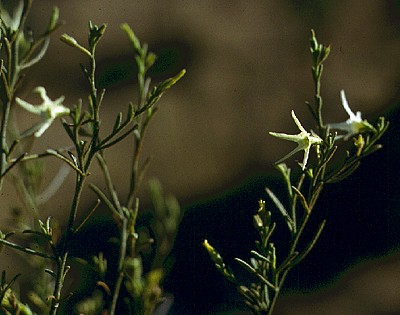 Branches with flowers (Giles Range, SA) Photo: A. Robinson © A. Robinson |
 Line drawing by M. Perkins (from L.Haegi, unpubl. thesis). |
 Illustration by G. Dashorst, Fl. S. Aus. 3, f. 559 partly (1986). |

Synonymy
Anthocercis angustifolia F. Muell., Trans. Philos. Soc. Victoria 1: 21 (1854) - see Taxon 35, p. 266 for discussion of this date.
T: near Mt Lofty, S.A., Mueller s.n.; syn: K, MEL.
Description
Erect shrub to 2.5 m, moderately to densely pubescent with glandular hairs; scattered non-glandular hairs sometimes present.
Leaves linear, rarely narrowly elliptic to obovate, sessile, 2–50 mm long, 0.5–6 mm wide, (the juvenile leaves larger), entire, pubescent, the lower leaves glabrescent.
Flowers solitary; pedicels 2–6 mm long. Calyx 4–7 mm long. Corolla 19–28 mm long, white to creamy-yellow; lobes linear, 12–20 mm long. Stamens 3–6 mm long.
Capsule broadly ovoid-ellipsoid to pear-shaped, 4–9 mm long. Seeds 1.7–2.2 mm long.
Distribution and ecology
Endemic to S.A., with scattered populations in the Adelaide Hills and the Flinders Ranges.
Grows in clay-loam in rocky habitats.
Notes
Leaves are often smaller in plants from the Flinders Ranges.
Phylogenetic studies by Garcia & Olmstead (2003) on the Tribe Anthocercideae using two chloroplast DNA regions included this species. The studies indicated that Anthocercis is monophyletic.
Reference: V.F.Garcia & R.G.Olmstead (2003). Phylogenetics of Tribe Anthocercideaea (Solanaceae) based on ndhF and trnL/F sequence data. Systematic Botany 28: 609-615.
Selected specimens
S.A.: Telowie Gorge, L. Haegi 1257 (AD, MO, NSW, PERTH); c. 10 km E of Adelaide, D.J.E. Whibley 1577 (AD, ADW).
Derivation of epithet
From the Latin angustus, narrow and folius, leaf, a reference to the narrow leaves of this species.
Images and information on web
There is an image of this species on the Friends of Black Hill and Morialta web site at www.fobhm.org/noframes/m_plant3.htm
A fact sheet for this species can be downloaded from the SA eFlora site.
Pharmacology: A discussion of the tropane alkaloids which occur in Anthocercis and other Anthocercideae can be found in Griffith & Lin (2000).
Ref: W.J. Griffin & G.D. Lin (2000). Chemotaxonomy and geographical distribution of tropane alkaloids. Phytochemistry 53: 627–628.
References to the possible toxic properties of Anthocercis species can be found with a search in the
FDA Poisonous Plant DatabasePlant status (if any)
Classified as Risk Code 3RCa (Briggs & Leigh, Rare or Threatened Australian Plants, 1995).
Gazetted in February 2008 as Rare Flora in S.A. under the National Parks & Wildlife Act 1972 - see the list at www.environment.sa.gov.au/biodiversity/threatened.html